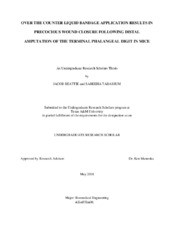Over the Counter Liquid Bandage Application Results in Precocious Wound Closure Following Distal Amputation of the Terminal Phalangeal Digit in Mice
| dc.creator | Tabassum, Sabeeha | |
| dc.creator | Beattie, Jacob | |
| dc.date.accessioned | 2020-07-22T19:51:26Z | |
| dc.date.available | 2020-07-22T19:51:26Z | |
| dc.date.created | 2018-12 | |
| dc.date.issued | 2018-05-04 | |
| dc.date.submitted | December 2018 | |
| dc.identifier.uri | https://hdl.handle.net/1969.1/188509 | |
| dc.description.abstract | CVS Liquid Bandage -- a “value brand” version of wound closure devices such as Dermabond -- following a distal, P3 amputation in mice initiates precocious wound closure; inducing a hypoxic microenvironment, and/or leading to reduced regeneration of the P3 digit. Previous research has shown that epidermal closure and a hypoxic environment are crucial in mammalian regeneration; this study looks to confirm and expand this knowledge and potentially lead to new discoveries through the use of different immunohistochemical assays: Hif1α, and Hypoxyprobe for hypoxia and EdU as a marker for cell proliferation. It is expected that the CVS Liquid Bandage will induce similar results to those produced by application of Dermabond: premature wound closure, creation of a hypoxic microenvironment, reduced degeneration and regeneration, and a similar expression pattern from the immunohistochemical assays. | en |
| dc.format.mimetype | application/pdf | |
| dc.subject | regeneration | en |
| dc.subject | wound closure | en |
| dc.title | Over the Counter Liquid Bandage Application Results in Precocious Wound Closure Following Distal Amputation of the Terminal Phalangeal Digit in Mice | en |
| dc.type | Thesis | en |
| thesis.degree.department | Health & Kinesiology | en |
| thesis.degree.discipline | Allied Health | en |
| thesis.degree.grantor | Undergraduate Research Scholars Program | en |
| thesis.degree.name | BS | en |
| thesis.degree.level | Undergraduate | en |
| dc.contributor.committeeMember | Muneoka, Ken | |
| dc.type.material | text | en |
| dc.date.updated | 2020-07-22T19:51:26Z |


